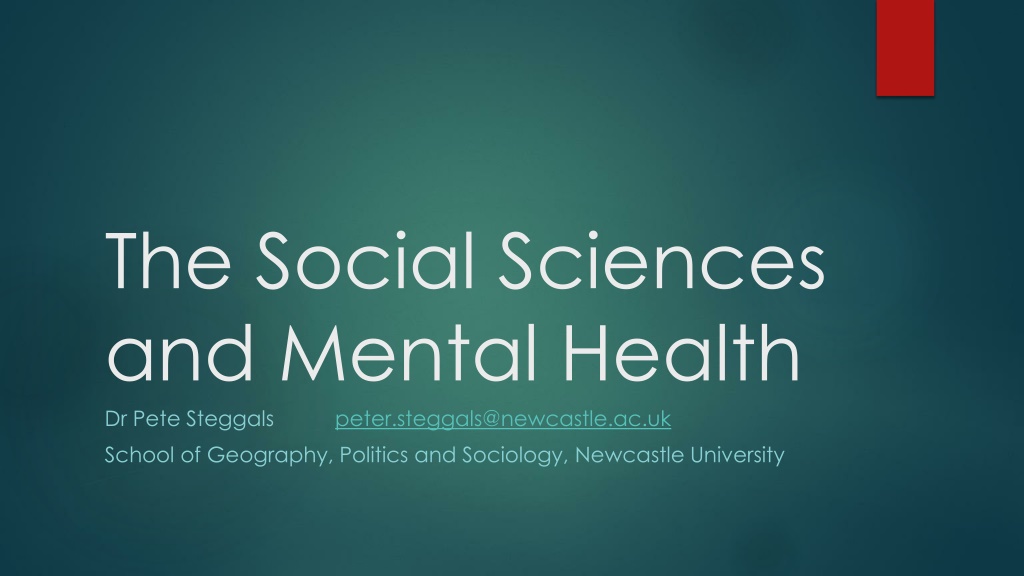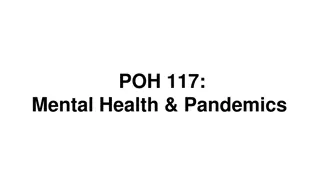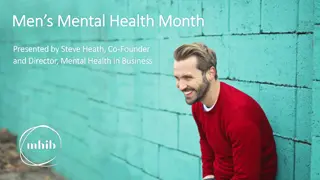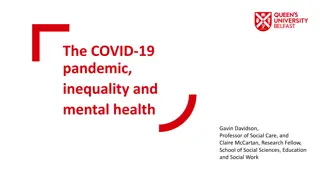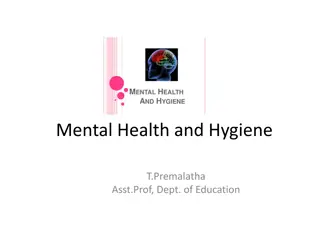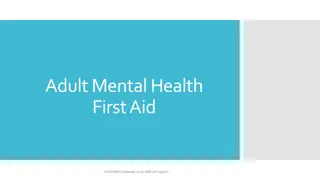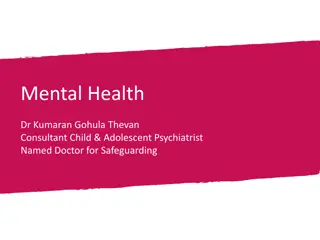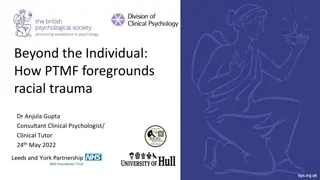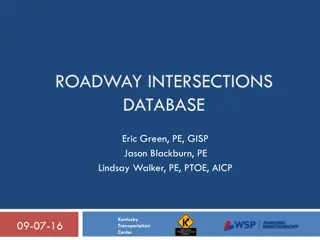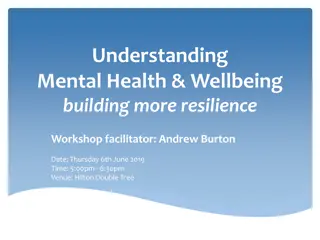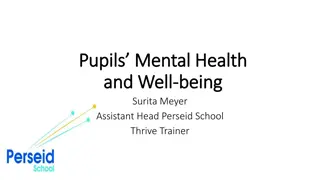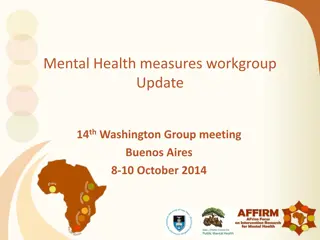Exploring the Intersection of Social Sciences and Mental Health
Delve into the dynamic relationship between social sciences and mental health, examining the sociocultural influences on mental illness through various theoretical perspectives. Explore methodologies in sociology and anthropology that analyze interpersonal relationships, power dynamics, and cultural diversity in the context of mental health research.
Download Presentation

Please find below an Image/Link to download the presentation.
The content on the website is provided AS IS for your information and personal use only. It may not be sold, licensed, or shared on other websites without obtaining consent from the author. Download presentation by click this link. If you encounter any issues during the download, it is possible that the publisher has removed the file from their server.
E N D
Presentation Transcript
The Social Sciences and Mental Health Dr Pete Steggals peter.steggals@newcastle.ac.uk School of Geography, Politics and Sociology, Newcastle University
Outline Introduction Relevance of the Session The Social of the Social Sciences Social Science in Medicine and Social Science of Medicine Sociocultural Effects in Mental Illness Theoretical Perspectives
The More Social of the Social Sciences Methodology Social ---------------------------------------------------------------- Individual Intersubjective Rational Agent (Relations/Interactions)
The More Social of the Social Sciences Methodology Social ---------------------------------------------------------------- Individual Ontology Intersubjective Rational Agent (Relations/Interactions)
The More Social of the Social Sciences Sociology Anthropology Social Theory Social Psychology
Sociology Intersubjectivity: Relationships/Interactions
Sociology Intersubjectivity: Relationships/Interactions Map and analyse patterns of relationships and interactions
Sociology Intersubjectivity: Relationships/Interactions Map and analyse patterns of relationships and interactions Conservation Change Social Facts Power Relations: social stratification/systemic inequality Lifeworld
Anthropology Study of human cultural diversity Ethnographic methodology Historically rooted colonialism Close relationship with Cultural Psychiatry
Social Theory Theoretical arm of the social sciences Models social systems
Social Psychology Rules and conventions that structure and regulate people s interactions and relationships. Generally more methodologically individualist
Social Science IN OF Medicine
Sociocultural Effects in Mental Illness Wen-Shing Tseng (2001) Handbook of Cultural Psychiatry San Diego: Academic Press
Sociocultural Effects in Mental Illness Wen-Shing Tseng (2001) Handbook of Cultural Psychiatry San Diego: Academic Press Pathogenic Pathoselective Pathoplastic Pathoelaborating Pathofacilitative Pathoreactive
Pathogenic Effects Sociocultural Causation Cultural ideas and beliefs contribute directly to stress and the formation of disorder e.g. Spoiled selfhood Anorexia Nonsuicidal Self-injury Koro Dhat
Pathoselective Effects Culturally influenced reaction patterns e.g. Japanese family suicides Malayan Amok (?) US Mass Shootings (American Amok?) Pathogenic + Pathoselective + Social Causation e.g. Zar Spirit Possession ( The Excuse )
Pathoplastic Effects Form/Content distinction e.g. Paranoid delusions
Pathelaborating Effectrs Patterns of behaviour are exaggerated or amplified to a (pathological?) extreme e.g. Japanese suicide (see Tseng, 2001) Sati in historical Hindu culture: non-pathogenic suicide? (See Bhugra, 2005)
Pathofacilitative Effects Some types of psychopathology may be more common in some cultures than others due to facilitating cultural ideas, values and practices e.g. Anorexia Mass shootings Bi-polar
Pathoreactive Effects How people expressing distress/disorder, and those around them, react to the distress/disorder due to the mediation of cultural ideas and values. e.g. PTSD Panic Attacks Strongly affected by expert/medical discourse, but . . . Looping effects (see Hacking, 1998, 2002)
Theoretical Perspectives Social Causation Hermeneutics Social Constructionism/Constructivism Social/Critical Realism Adapted from Rogers and Pilgrim (2014) A Sociology of Mental Health and Illness (5thedition) Berkshire: McGraw-Hill
Social Causation Epidemiology but with an eye on social, cultural, economic and political causation Big in the post-war period, but led to anti-psychiatry Social causation accepts diagnostic categories as valid and uses these to look for correlations with social data Particular focus on socioeconomic inequality (see U ren (2011) The Social Perspective Toronto: University of Toronto Press)
Social Causation Weakness of social causation approach: Looks over the lived experience of individual people Conceptual questions over validity of categories Tends to map cases not causes Correlation is not causation
Hermeneutics Hermeneutics = interpretation Strong conceptual connection to the idea of idiomatic psychopathology and culture bound syndromes Also to classic conversion hysteria (Freud) Enters sociology through Critical Theory and the Frankfurt School
Hermeneutics What connections can be established, in a specific social group, in a specific period of time, in specific countries, between the group, the changes in the psychic structure of its individual members and the thoughts and institutions that are a product of that society, and that have, as a whole, a formative effect upon the group under consideration? - Max Horkheimer
Hermeneutics: the case of self- injury Nonsuicidal self-injury as an idiom of personal distress, emotional dysphoria and social estrangement The meanings in the idiom are related to the language of the idiom Meanings nest along axes of continuity
Hermeneutics: the case of self- injury An example of an axis of continuity: I felt so strange that evening numb but silently screaming in pain. Why couldn t I scream out loud? Why couldn t I show people how much pain I felt inside?...As the night drew in, I sat alone and in silence, holding back the tears I was too afraid to show. My mind was flooded with disturbing memories, most of which had been buried for a very long time. The wall that had contained these memories took many years to build, yet within hours it had fallen allowing the thoughts and images to torment me once more, I couldn t push them back to rebuild it....My mind jumped from one event in my disastrous childhood to another I had no control and the volcano inside me was growing dangerously close to eruption. I d had an unusual thought the night before. It was a thought I didn t want to listen to, but a voice deep inside said it would calm the turmoil. My gaze drifted to the discarded plastic that once held four cans of beer together: as the melted plastic landed on the flesh of my forearm, the screaming inside suddenly stopped and I drifted off to sleep - Allie
Hermeneutics: the case of self- injury An example of an axis of continuity: The Expressive Imperative The Psychodynamic Subject Homo Clausus
Social Constructionism Also known as Social Constructivism The social construction of what? Things Representations (ideas, knowledge, concepts, categories) Things: anti-realism about, and social construction of, mental illness: Thomas Szasz Ideas: Michel Foucault
Michel Foucault Power/knowledge Genealogy The rise of the total institutions The history of psychiatry But a word of caution . . .
Social (or Critical) Realism A lot like social constructionism, but with a reminder that reality is (behind the representation of reality) really real, and it is not frictionless Emphasises the role people have as agents in the construction and reconstruction of our maps of reality Contra hermeneutics, causes may operate beyond the experience of social actors Construal more than construction
Thank you for you time! Contact me: peter.steggals@newcastle.ac.uk
